After you have typed all the necessary text in Word, or you have been given an already typed document, you can proceed to. And one of the items that you have to do is adjust the indents for the lines in the document.
In this article, we'll look at how to indent an entire paragraph, indent only the first line, and indent text for a paragraph.
Let's start with the first question. Indent an entire paragraph in Word from established boundaries fields can be on the right and on the left side. You can set indents using special markers on the top ruler of the document. If it is not displayed for you, go to the "View" tab and in the "Show" group, check the box "Ruler".
WITH right side there is only one marker. To set padding to right for a paragraph, click on it with the left mouse button and drag the marker to the desired distance on the ruler. The division value of the ruler is 0.25 cm.
If you did not select any text, then the indent will be made for the paragraph in which the cursor is set. If you want to make the same indent for all text, select it by pressing the combination "Ctrl + A" , and drag the marker. To indent different paragraphs in the text, select them and drag the handle.
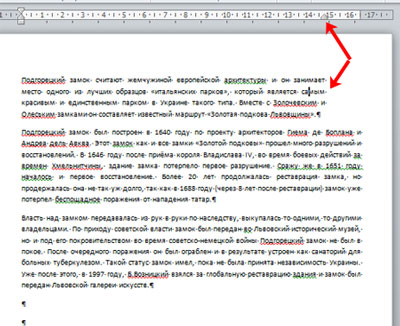
There are three markers on the left side of the ruler. In order to indent left in Word for all the text in the paragraph, left-click on the bottom marker, it looks like a rectangle, and drag it to the desired distance on the ruler.
In this case, select the entire text or individual paragraphs.
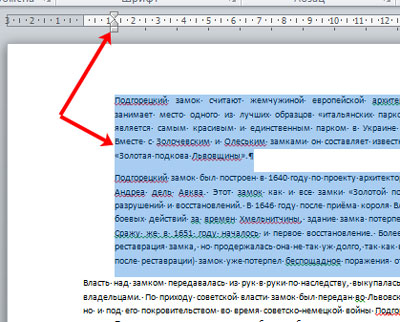
If you need indent the first line, it is also called the red line in the Word, then on the ruler on the right side, drag the top marker to the desired distance. Considering that the division value is 0.25 cm, in the example we made an indent equal to 1.25 cm.
You can read a detailed article about by clicking on the link.
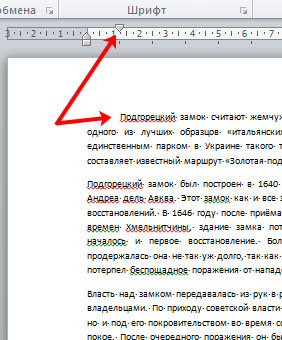
With the last marker, you can indent text in a paragraph. Click on it with the left mouse button and set it to the desired distance on the ruler. This will move all text in the paragraph, except for the first line, by the specified value.
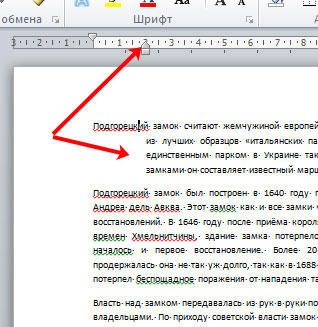
All the considered indents in the Word can be done in another way. To do this, on the "Home" tab in the "Paragraph" group, click on the small black arrow in the lower right corner.
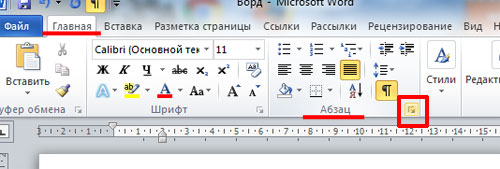
The Paragraph dialog box will open. In the corresponding fields in it, you can set the exact values for the indents. At the same time, below, in the "Sample" area, you can see how your text changes.
You can set the indent for the entire paragraph by specifying the values in the fields "Left", "Right", paragraph indent is set in the field "First line" - "Indent", the "Protrusion" for the text in the paragraph is also set there. When choose desired values, click OK .
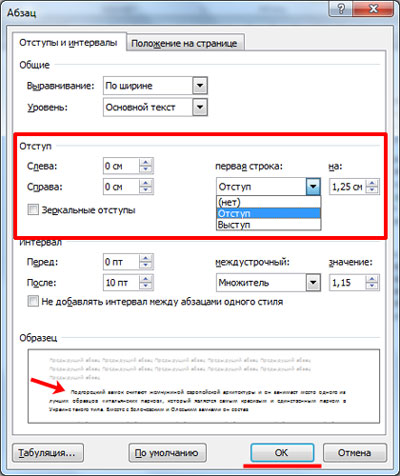
If you are interested, read the article by clicking on the link.
I think now you will definitely be able to make indents and ledges in the text for the entire paragraph or only for the first line in the Word.
In Word, you can use several ways to separate paragraphs. For example, indent at the beginning of the first line of each paragraph.
I had to see how those who do not know how to work in Word suffer from paragraph indents. I bet that you also press the Tab key at the beginning of each paragraph. Of course, this is unprofessional, but you can be forgiven - you are just learning. So remember: Word itself will indent paragraphs - automatically!
In the following sections, we will look at several options for paragraph indentation.
Auto indent the first line of a paragraph
No, no and NO! You don't have to touch the Tab key! Word itself will create the necessary indents. However, this requires that you first complete the following steps.
- Choose the command Format › Paragraph.
A dialog box will appear Paragraph. Click on the tab tab Indents and spacing(Fig. 12.2).
- Open the First Row list.
You will find it on the right side of the area Indent dialog box.
- Select Indent from the First Line list.
- In the To field, enter the amount of indentation.
Unless you messed something up, this field defaults to 1.27 cm. This means that Word will shift the first line of each paragraph half an inch from the left margin. IN this case measurements are in centimeters (or inches, depending on your computer settings), not points.
- Click the OK button.
The selected text or the current paragraph (where the cursor is located), as well as all subsequent paragraphs on the first line, will be indented.
To unindent, follow the same steps, but in the list First line select element ( No). Click the button OK.
There are two ways to separate paragraphs in Word. First, you can increase the white space after a paragraph, as described in the previous section. The second way is not to increase the spacing between paragraphs, but to indent at the beginning of the first line of each paragraph.
How to create a hanging indent
The hanging indent has nothing to do with an unsolved crime. This is an indent, in which only the first line starts in the usual way from the left margin, and all the rest are indented - the paragraph seemed to cling to the edge of the page with the left hand. For example, I formatted the following text in this way.
Stain remover "Surprise". New washing powder, which does not remove stains, has an unpleasant odor and contaminates environment. But everything is fair! For wealthy clients. (When ordering more than 10 packs - an extra charge of 8%.)
To get such a paragraph, do the following.
- Position the cursor on the paragraph where you want to set the hanging indent.
You can also place the cursor at the point where you want to start a new paragraph with a hanging indent. (You can select a block of text.)
- Click CTRL+T, the keyboard shortcut for the Protrusion command.
CTRL+T moves the entire paragraph up to the first tab stop, leaving the first line in place.
These actions can be performed using the dialog box Paragraph. Listed First line select item ledge, in the On field, enter a value (usually half an inch - 1.27 cm). Click the button OK!
- Rest assured, in a paragraph with a hanging indent, absolutely all lines will be shifted, except for the first one.
- If you want to increase the indent, press the keys CTRL+T repeatedly.
- It's strange that Word provides a keyboard shortcut to create a hanging indent, but there is no shortcut to create a first line indent. The latter seems to me to be much more common.
- To cancel the hanging indent, click CTRL+SHIFT+T. This keyboard shortcut will make your paragraph "hands on at the seams" vividly.
An indent is the distance between text and the left or right margin of a page. You can manually adjust the offset using horizontal ruler(how to turn on the display, see subsection "Ruler" section 1.4).
Indentations can be divided into three types:
Indent left - sets the position of the entire paragraph relative to the left margin of the page, to change it, use the marker shown in Fig. 4.19;
Rice. 4.19. Indent Marker Left
Indent to the right - sets the position of the entire paragraph relative to the right margin of the page, to change it, use the marker shown in Fig. 4.20;

Rice. 4.20. Right Indent Marker
First line indent - determines the position of the first line of the paragraph, to change it, use the marker shown in Fig. 4.21.

Rice. 4.21. First line indent marker
Overhangs can be used along with indents. An indent moves text to the left of the original line of text without extending past the first line of a paragraph. Typically, protrusions are used to create numbered and bulleted lists, pointers. To install the protrusion, use the marker (Fig. 4.22).

Rice. 4.22. Protrusion marker
You can adjust indents and protrusions not only using the horizontal ruler, but also in the Paragraph dialog box. To do this, do the following.
1. Select the paragraph for which you want to set the formatting.
2. Open the Paragraph window by clicking on the corresponding button of the Paragraph group (see Figure 4.14). Click the Indents & Spacing tab.
3. To set the right and left indents, enter the value of the right indent in the Right field and the left indent in the Left field of the Indent area (Fig. 4.23). The indent can have not only a positive but also a negative value. If you specify a negative indent value, the text will be placed in the right or left margin.
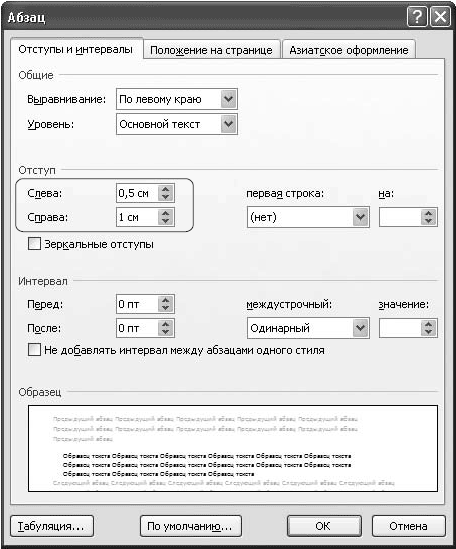
Rice. 4.23. Setting indents in the Paragraph window
4. To set an indent or indent for the first line, select Indent or Indent from the First Line list and enter a value in the On field.
5. Press the OK button to confirm the changes.
You can also use:
Tab key on the keyboard;
Keyboard shortcut Ctrl+M (to set indent) and Ctrl+Shift+M (to remove indent);
Buttons Increase indent
to set indent and Decrease indent
to remove the indent, which are in the Paragraph group of the Home tab on the ribbon. Using them, it is impossible to set a negative indent value.
The paragraph configuration is characterized by top and bottom indents, left and right spacing, line spacing, first line indentation, page justification mode, and some other parameters. Let's learn how to adjust these values.
1. Start Word and type a few dozen words in the automatically opened new document, for example, enter the text of any paragraph of this book. Note that when it reaches the right edge of the page, the text automatically wraps to the next line.
2. When you have finished entering a paragraph, press the Enter key. The text cursor will move to a new line, marking the end of the current paragraph and preparing word processor to enter the next.
3. Enter a few more paragraphs.
4. Clicking on the button Layout mode switch to page layout view, which allows you to see the exact formatting of the text. (Use this document view throughout the lesson.)
5. If there are no vertical and horizontal rulers on the screen, turn them on with the command View > Ruler. Now Word window will look something like the one shown in Fig. 6.1. To set the distance from the borders of the left and right margins of the page to the paragraphs of a certain block of text, you need to adjust the indents of the block. When changing the width of the page margins, the paragraph sizes are modified so that the indents from the edges of the margins remain unchanged. To adjust the indentation of a block of text, you must first select this text. If you want to modify the parameters of only one paragraph, just place the text cursor in it.
6. Highlight the second and third paragraphs.
Rice. 6.1. Five paragraphs and rulers in page layout view in Word
7. On the left side of the horizontal ruler, find the triangular marker First line indent, whose vertex is pointing down, grab it with the mouse and drag it to the right by 3 cm. By moving this marker, you can change the position of the beginning of the first lines of the selected paragraphs without changing the indents of the rest of the text. Note that the first line can start either to the right (indent) or to the left (indent) of the body text.
8. Drag right 1cm marker ledge, which has the shape of a triangle, the apex of which is directed upwards. The left indent of the body of the paragraphs will change, but the indentation of the first lines will remain the same.
9. On the left side of the horizontal ruler there is another marker shaped like a rectangle - Indent left. Drag it to the right 1 cm. You will see that moving this marker is the same as moving the markers in sync First line indent And ledge by the same distance, that is, it leads to an offset of the left edge of the paragraph relative to the page margin.
10. Click on the text of the second paragraph, deselecting the block of text and placing the cursor in the body of this paragraph.
11. Drag to the left 4 cm marker Indent right located on the right side of the horizontal ruler. It sets the right margin of a paragraph.
After all the operations done, the text looks as shown in Fig. 6.2.
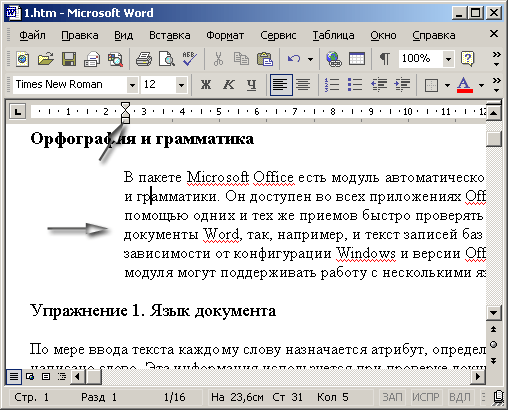
Rice. 6.2. Setting indents in Word
12. Click the button Centered toolbar Formatting.
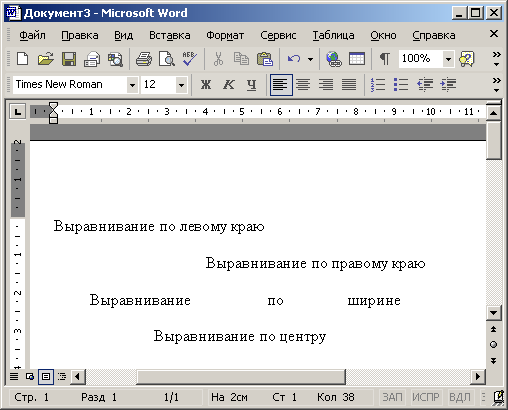
Rice. 6.3. Leveling Modes
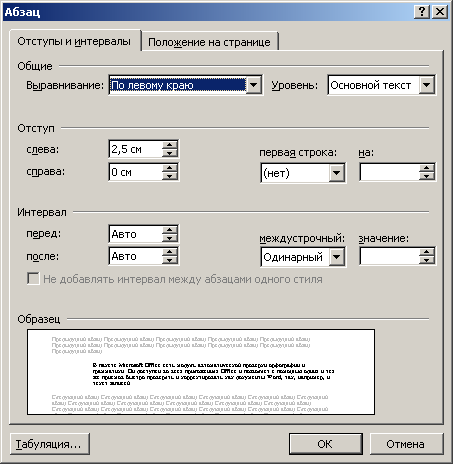
Rice. 6.4. Paragraph Options Dialog Box in Word
13. Select the third paragraph and click on the button Right the same toolbar.
14. Click on the fourth paragraph and then on the button By width. Now the first four paragraphs of text show four modes of text alignment (fig. 6.3).
15. Select the second, third and fourth paragraphs and select the command Format > Paragraph. tab Indents and spacing the dialog window that opens (Fig. 6.4) allows you to set paragraph indents and alignment mode, which we configured using the horizontal ruler and toolbar buttons Formatting. Chapter Interval the same tab allows you to set the spacing between lines within a paragraph and the spacing between paragraphs.

Rice. 6.5. Adjust spacing in Word
16. Enter the number 6 in the counter before.
17. In the line spacing list, select One and a half(1.5 tines).
18. Click the button OK. The intervals in the three selected paragraphs will change and become as shown in Fig. 6.5. Please note that the area Sample dialog boxes Paragraph allows you to observe the influence of the entered values on the appearance of the current paragraph even before the final application of the selected parameter values to the text of the document.
19. Save the document, you will need it in the following exercises.
| Internet Explorer | Chrome | Opera | safari | Firefox | Android | iOS |
| 4.0+ | 1.0+ | 4.0+ | 1.0+ | 1.0+ | 1.0+ | 1.0+ |
Task
Add an indent to the first line of each paragraph.
Solution
When it comes to setting paragraph indentation, also known as redline, it's best to use the text-indent style property. Its value determines how much to shift the text of the first line to the right from its original position. The width of the text block does not change and remains set initially. The amount of padding can be specified in pixels, percentages, or other available units (example 1).
Example 1: Indenting the first line
HTML5 CSS 2.1 IE Cr Op Sa Fx
The Babylonian Pandemic, according to biblical tradition, is the failed attempt of King Nimrod to build a pillar in Babylon as high as the sky. God, angry with people for their reckless desire, decided to punish the builders: he mixed their language so that they no longer understood each other, were forced to stop construction and gradually scattered around the world. From here, as the ancients explained, the difference in languages \u200b\u200bwent.
In the usual sense Babel means disorder, confusion with a large crowd of people.
Result this example shown in fig. 1.
